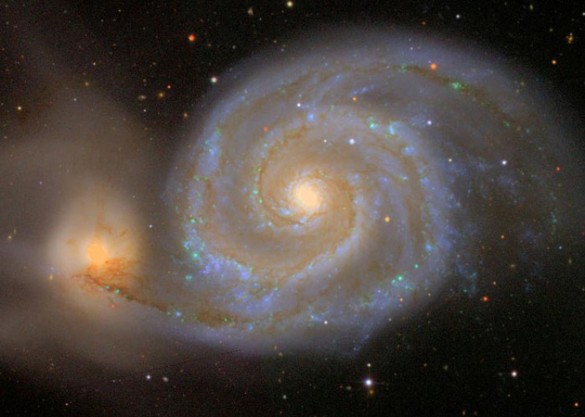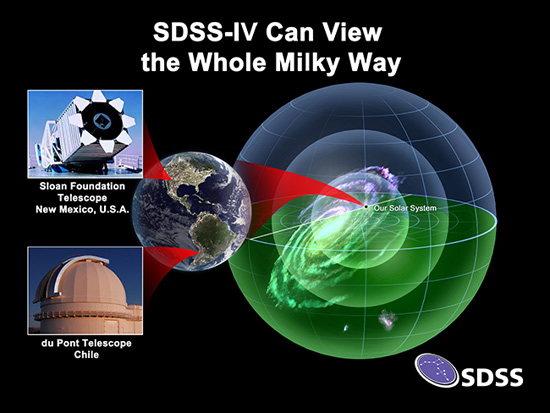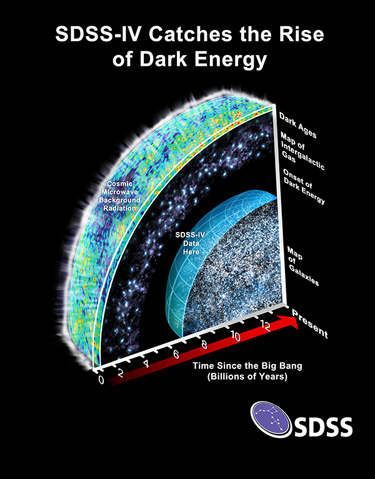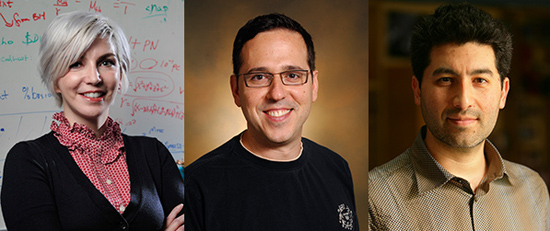
Bankrolled primarily by the Alfred P. Sloan Foundation for the last eight years, the Sloan Digital Sky Survey is one of the most ambitious and influential data-gathering efforts in the history of astronomy. This month it is launching a major new program called SDSS-IV, and Vanderbilt astronomers are directly involved.
In the past, the survey has relied on a dedicated telescope in New Mexico, which has blocked its view of a good portion of the southern sky, including a big slice of the Milky Way galaxy. SDSS-IV will fill this gap in its coverage with the added participation of a telescope in Chile. As a result, one of its goals is to map the chemical compositions and motions of stars throughout the entire Milky Way in unprecedented detail in order to provide new insights into the origin and evolution of our home galaxy.

In addition to the Milky Way, the new program will be making detailed maps of the internal structures of thousands of nearby galaxies to determine how they have grown and changed over billions of years. In the past, most measurements of the spectra of other galaxies have been based on light coming from a small area at the center of the galaxy. Using a cutting-edge measurement device that employs bundles of optical fibers, the survey will begin collecting data from a number of points on each galactic disk. With this information, astronomers hope to better understand the “life cycle” of present-day galaxies beginning with their birth and assembly, through their growth due to star formation and merging, to their eventual fadeout when star formation ends.

At the cosmic scale, SDSS-IV is also taking on the challenge of measuring the expansion of the universe during a poorly understood five-billion-year period of its history. This will require mapping a entire new set of galaxies and quasars.
The new survey is a collaboration of more than 200 astronomers at more than 40 institutions. Vanderbilt joined the SDSS program in 2009. This year, Professor of Astronomy Keivan Stassun was elected chair of the SDSS executive committee.
“The previous Sloan Digital Sky Surveys have consistently been ranked as the world’s most productive and impactful projects in astronomy,” Stassun said. “For Vanderbilt to be involved in SDSS-IV from its inception means the highest level of international exposure for us and our students. It also gives Vanderbilt astronomers direct access to cutting-edge data ahead of the rest of the world, which positions us for maximum scientific impact and strong career prospects for our students in the years ahead.”

The Vanderbilt astronomers participating in the survey include: Professor of Physics and Astronomy Keivan Stassun; Associate Professor of Physics and Astronomy Andreas Berlind; Associate Professor of Physics and Astronomy Kelly Holley-Bockelmann; VIDA Postdoctoral Fellow Jonathan Bird; postdoctoral associates Jillian Bellovary, Martin Paegert and Manodeep Sinha; and graduate students Fabienne Bastien, Victor Calderon, Jonathan Florez, Meagan Lang, Baile Li, Trey Mack, Qingqing Mao, Lauren Palladino and Jennifer Piscionere.
SDSS-IV is managed by the Astrophysical Research Consortium for the Participating Institutions of the SDSS Collaboration, including the Carnegie Institution for Science, Carnegie Mellon University, the Chilean Participation Group, Harvard-Smithsonian Center for Astrophysics, Instituto de Astrofisica de Canarias, Johns Hopkins University, Kavli Institute for the Physics and Mathematics of the Universe (IPMU) / University of Tokyo, Lawrence Berkeley National Laboratory, Leibniz Institut fur Astrophysik Potsdam (AIP), Max-Planck-Institut fur Astrophysik (MPA Garching), Max-Planck-Institut fur Extraterrestrische Physik (MPE), Max-Planck-Institut fur Astronomie (MPIA Heidelberg), National Astronomical Observatory of China, New Mexico State University, New York University, Ohio State University, Pennsylvania State University, Shanghai Astronomical Observatory, United Kingdom Participation Group, Universidad Nacional Autonoma de Mexico, University of Arizona, University of Colorado-Boulder, University of Portsmouth, University of Utah, University of Washington, University of Wisconsin, Vanderbilt University and Yale University.